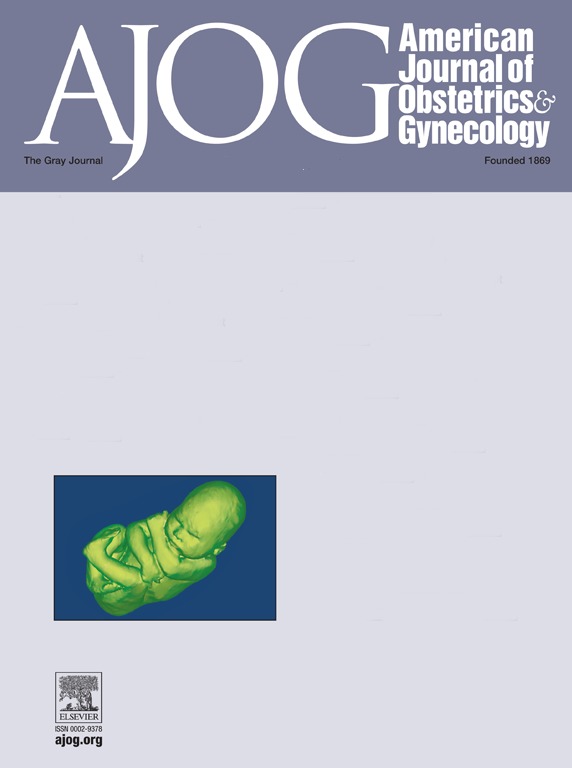Association of Reproductive Access Restrictions and Out-of-State Abortion Care in Colorado, an Interrupted Time Series Analysis for 2018-2024.
IF 8.7
1区 医学
Q1 OBSTETRICS & GYNECOLOGY
引用次数: 0
Abstract
OBJECTIVE Access to abortion has changed dramatically in the United States in recent years, both at the federal and state level. For nearly fifty years, the right to abortion was considered federally protected right under the Roe v. Wade (1973) recognition of privacy rights under the 14th Amendment. In September 2021, Texas passed SB8 which implemented a 6-week restriction on access to abortion. The following year, in 2022, the Supreme Court issued the Dobbs v. Jackson Women's Health Organization decision. Dobbs reversed Roe v. Wade and shifted determinations about legal access to the states, several of which already had trigger bans awaiting the potential removal of this Constitutional right. To explore how these legal alterations to access are associated with changes in travel into abortion-rights protective states for abortions by residents of abortion-restrictive states, we sought to measure monthly abortion trends. Specifically, our goal is to compare monthly abortion utilization in Colorado by resident status before and after introduction of abortion access restrictions, while adjusting for overall temporal trends. STUDY DESIGN Utilizing monthly count data for induced abortions from the Colorado Department of Health and Environment (CDPHE) from 2018-2024, an interrupted time series analysis was used to assess the association between changes in federal and state law and the number of out-of-state patients traveling to Colorado for abortions. Secondary analysis focused specifically on Texas residents. Quasi-Poisson time series regression models adjusted for time in two ways: first, we used a linear time adjustment to account for any long term trends, and second, we used harmonic terms to account for any seasonal variation present in the data. RESULTS Out-of-state residents were over twice as likely to travel to Colorado after Dobbs compared to before: Rate Ratio (RR): 2.14 (95% confidence interval (CI): 1.54, 2.99, p<0.001). Texas residents were over 7 times more likely to travel to Colorado for abortions after the enactment of SB8. RR: 7.86, (95 % CI: 3.30, 20.09, p<0.001). Although initial spikes in travel to Colorado, particularly by Texas residents, have shown a gradual reduction over time, these patterns have not returned to baseline. This may indicate a long-term shift in how abortion care is provided and obtained in the United States in the wake of changes in the law. COMMENT There has been a significant increase in the number of patients traveling to Colorado for abortions associated with changes to both federal and state laws, carrying implications for clinicians and patients alike. While some of the initial demand for abortions from out-of-state residents appears to have reduced in Colorado, it has not returned to baseline and may reflect a permanent shift in how and where abortion care is provided.科罗拉多州生殖准入限制和州外堕胎护理协会,2018-2024年中断时间序列分析。
目的近年来,在美国联邦和州一级,堕胎的可及性发生了巨大变化。近五十年来,堕胎权被认为是联邦保护的权利,根据罗伊诉韦德案(1973年),第14修正案承认隐私权。2021年9月,德克萨斯州通过了SB8法案,对堕胎实施了6周的限制。第二年,也就是2022年,最高法院发布了多布斯诉杰克逊妇女健康组织案的判决。多布斯推翻了罗伊诉韦德案,并改变了有关合法进入各州的决定,其中几个州已经有了触发禁令,等待这项宪法权利可能被取消。为了探索这些法律变更与堕胎限制州的居民前往堕胎权利保护州进行堕胎的变化之间的关系,我们试图衡量每月的堕胎趋势。具体来说,我们的目标是比较科罗拉多州在引入堕胎准入限制之前和之后按居民身份的每月堕胎利用率,同时根据总体时间趋势进行调整。研究设计利用2018-2024年科罗拉多州卫生与环境部(CDPHE)每月人工流产计数数据,采用中断时间序列分析来评估联邦和州法律变化与州外前往科罗拉多州堕胎的患者数量之间的关系。二级分析专门针对德克萨斯州居民。准泊松时间序列回归模型以两种方式调整时间:首先,我们使用线性时间调整来解释任何长期趋势,其次,我们使用调和项来解释数据中存在的任何季节变化。结果州外居民在多布斯事件发生后前往科罗拉多州的可能性是事件发生前的两倍多:比率比(RR): 2.14(95%可信区间(CI): 1.54, 2.99, p<0.001)。在SB8法案颁布后,德克萨斯州居民前往科罗拉多州堕胎的可能性增加了7倍以上。RR: 7.86, 95% CI: 3.30, 20.09, p<0.001)。虽然最初前往科罗拉多州旅游的高峰,特别是德克萨斯州居民,随着时间的推移逐渐减少,但这些模式并没有回到基线。这可能表明,随着法律的变化,美国提供和获得堕胎护理的方式发生了长期变化。由于联邦和州法律的变化,前往科罗拉多州堕胎的患者数量显著增加,这对临床医生和患者都有影响。虽然科罗拉多州的一些州外居民对堕胎的最初需求似乎有所减少,但还没有回到基线水平,这可能反映了堕胎护理的方式和地点的永久性转变。
本文章由计算机程序翻译,如有差异,请以英文原文为准。
求助全文
约1分钟内获得全文
求助全文
来源期刊
CiteScore
15.90
自引率
7.10%
发文量
2237
审稿时长
47 days
期刊介绍:
The American Journal of Obstetrics and Gynecology, known as "The Gray Journal," covers the entire spectrum of Obstetrics and Gynecology. It aims to publish original research (clinical and translational), reviews, opinions, video clips, podcasts, and interviews that contribute to understanding health and disease and have the potential to impact the practice of women's healthcare.
Focus Areas:
Diagnosis, Treatment, Prediction, and Prevention: The journal focuses on research related to the diagnosis, treatment, prediction, and prevention of obstetrical and gynecological disorders.
Biology of Reproduction: AJOG publishes work on the biology of reproduction, including studies on reproductive physiology and mechanisms of obstetrical and gynecological diseases.
Content Types:
Original Research: Clinical and translational research articles.
Reviews: Comprehensive reviews providing insights into various aspects of obstetrics and gynecology.
Opinions: Perspectives and opinions on important topics in the field.
Multimedia Content: Video clips, podcasts, and interviews.
Peer Review Process:
All submissions undergo a rigorous peer review process to ensure quality and relevance to the field of obstetrics and gynecology.

 求助内容:
求助内容: 应助结果提醒方式:
应助结果提醒方式:


